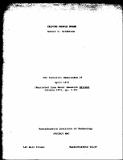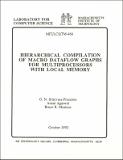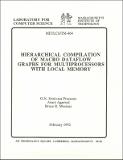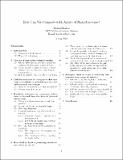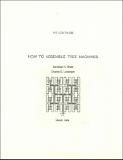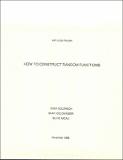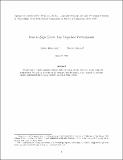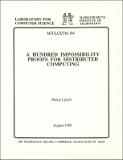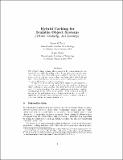Browsing LCS Technical Memos (1974 - 2003) by Title
Now showing items 190-209 of 492
-
Game Tree Searching by Min/Max Approximation
(1986-09) -
A General Framework for Highly Available Services based on Group Communication
(2000-11)We present a general framework for building highly available services. The framework uses group communication to coordinate a collection of servers. Our framework is configurable, in that one can adjust parameters such as ... -
Generalized Planar Matching
(1985-04)In this paper, we prove that maximum planar H-matching (the problem of determining the maximum number of node-disjointed copies of the fixed graph H contained in a variable planar graph G) is NP-complete for any connected ... -
The Generalized Railroad Crossing: A Case Study in Formali Verification of Real-time Systems
(1994-11)A new solution to the Generalized Railroad Crossing problem, based on timed automata, invariants and simulation mappings, is presented and evaluated. The solution shows formally the correspondence between four system ... -
Guaranteeds Partial Key-escrow
(1995-08) -
Hardware Estimatino of a Process' Primary Memory Requirements
(1977-01)It is shown that a process' primary memory requirements can be approximated by use of the miss rate in the Honeywell 6180's page table word associative memory. This primary memory requirement estimate was employed by an ... -
Helping People Think
(1971-04)Everyone, today, is familiar with the use of machines to ease physical burdens. Since the dawn of civilization, man's progress in gaining control over his environment has been largely determined by the power and sophistication ... -
Hierarchical Compilation of Macro Dataflow Graphs for Multiprocessors with Local Memory
(1992-10)This paper presents a hierarchical approach for compiling macro dataflow graphs for multiprocessors with local memory. Macro dataflow graphs comprise several nodes (or macros operations) that must be executed subject to ... -
Hierarchical Compilation of Macro Dataflow Graphs for Multiprocessors with Local Memory
(1992-12)This paper presents a hierarchical approach for compiling macro dataflow graphs for multiprocessors with local memory. Macro dataflow graphs comprise several nodes (or macros operations) that must be executed subject to ... -
Hierarchical Inequality Reasoning
(1987-02)This paper describes a program called BOUNDER that proves inequalities between elementary functions over finite sets of constraints. Previous inequality algorithms perform well on some subset of the elementary functions, ... -
Hoare's Logic Is Not Complete When It Could Be
(1982-08)It is known (cf.[2]) that is the Hoare rules are complete for a first-order structure A, then the set of partial correctness assertions true over A is recursive in the first-order theory of A. We show that the converse is ... -
How Can We Compute with Arrays of Nanstructures?
(1994-08)In part the goal of the Ultra Program is to extract useful computation from nanometer scale effects. To accomplish this goal those of us who are computer scientists must communicate clearly to those of you who are chemists ... -
How to Assemble Tree Machines
(1984-03)Many researchers have proposed that ensembles of processing elements be organized as trees. This paper explores how large tree machines can be assembled efficiently from smaller components. A principal constraint considered ... -
How to Build Scalable On-Chip ILP Networks for a Decentralized Architecture
(2000-04)The era of billion transistors-on-a-chip is creating a completely different set of design constraints, forcing radically new microprocessor archiecture designs. This paper examines a few of the possible microarchitectures ... -
How to Construct Random Functions
(1982-11)We assume that functions that are one-way in a very weak sense exist. We prove that in probabilitic polynomial time it is possible to construct deterministic polynomial time computable functions g:{1,…,2^k} -> {1,…,2^k} ... -
How to Share a Secret
(1979-05)In this paper we show how to divide data D into n pieces in such a way that D is easily reconstructable from any k pieces, but even complete knowledge of k-1 pieces reveals absolutely no information about D. This technique ... -
How to Sign Given Any Trapdoor Permutation
(1990-06)We present a digital signature scheme which is based on the existence of any trapdoor permutation. Our scheme is secure in the strongest possible natural sense: namely, it is secure against existential forgery under ... -
Hybrid Atomicity for Nested Transactions
(1992-10)This paper defines the notion of hybrid atomicity for nested transaction systems, and presents and verifies an algorithm providing this property. Hybrid atomicity is a modular property; it allows the correctness of a system ... -
Hybrid Caching for Scalable Oject Systems (Think Globally, Act Locally)
(1994-04)Object-based client caching allows clients to keep more frequently accessed objects while discarding colder objects that reside on the same page. However, when these objects are modified and sent to the server, it may need ...






